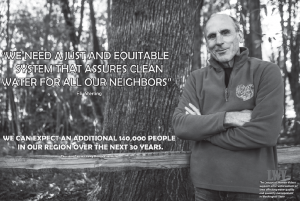[Note: This is Part 3 of a 4-part series describing steps the Olympia Carpenters took to revitalize their union at a time when good union jobs were under threat. Part 1 appeared in November, and Part 2 in December.]
Organizing your organizing job
In May 1989 I graduated from the New School for Union Organizers – a program of the Labor Center at TESC. I had also been injured in a fall working on a freeway job for Gordon Kruse Construction. At first, I was very concerned about how I would earn a living. I needed spinal surgery and I would have to rely at least for some months on State Labor & Industries disability benefits.
But it’s funny how disaster can lead to new beginnings. Over that summer someone said to me, “an organizer organizes their own organizing job.” And with that, my life changed and led to my becoming an organizer with the Southern Puget Sound District Council of Carpenters. It was a position in the Carpenters Union that hadn’t been seen in maybe fifty years. It meant I could now put to work the skills I had developed in the New School and even realize my passion to help my fellow carpenters.
Knowing your position
Members of the Olympia Carpenters began researching construction activity in our county in 1990 as part of our education about where we stood within the geographic boundaries of Thurston County. We learned that all residential carpenter construction in the area was being performed by un-represented carpenters. New commercial construction mainly in Lacey, Olympia and Tumwater had more project jobsites with non-union carpenters than union sites.
Making lists, listening and learning
Our local Organizing Committee began sending volunteers to these jobsites. We would introduce ourselves to the carpenters with the aim of making contact and creating a list of who these carpenters were and how to stay in touch with them. On many job sites, former union members were providing their skills to their non-union employer. Many had a story of why they were no longer union members. We listened and learned. These un-represented carpenters were surprised that union carpenters came to talk with them—in their past experience, the union had shunned them. This began what would later become our District Council’s Carpenter to Carpenter program.
Testing skills developed at the New School
We also encountered a special challenge when a non-union contractor arrived in town to build the new Natural Resources Building (NRB) on the East Capitol Campus. We discussed the situation and decided a little “organizing” was needed. We also wanted to practice and hone some of our organizing tactics. We saw the possibility of making an example that would build our reputation as a group to be reckoned with. We would convince the contractor Hensel Phelps (HP), and the state agency, Department of General Administration (GA), of the error of their ways. This effort became a laboratory and a proving ground for our New School education, testing skills such as research, intelligence gathering, bottom-up organizing, salting, putting pressure on an enemy, and building alliances.
Research. We used The Art of War by Sun Tzu to instruct us in our effort. We understood that “war” was of vital importance to our union. Thus, we needed to make many calculations and estimates in order to prevail in our battle. “Know your enemy, and yourself, and you will be victorious” (Sun Tzu, The Art of War). We determined to gather information about the who, what, where, and how of the NRB project.
Intelligence gathering. First, we made an alliance with AFSCME members working as city garbage truck drivers that enabled us to get inside information on the day-to-day administration of the project. Some drivers were familiar to our members as we had all grown up in Olympia. Familiarizing yourself with those you know in the community can provide organizing dividends. The g-men’s assistance allowed us to survey the trash from the HP offices after they made their weekly pick up. From plastic trash bags we selected and studied project flowcharts and budgets the NRB job.
We also became privy to internal notes and communication among project staff. When we found notes mocking State Labor & Industries Safety Inspectors, we shared this info with them. This brought State Safety Inspectors to make a nest in the neighboring Licensing Building with a nice view of the NRB job site. After that, the job site was shut down a few times due to safety violations, which put pressure on HP and resulted in some fines. One violation arose from the unsafe method used to lift large, heavy concrete form panels over the heads of workers.
The fines and stoppages delayed the job schedule for HP and GA staff. It cost HP money, which ate into their project profit. How did we know about the dollar consequences to HP’s job? It was in the regular project flowcharts that we reviewed every week, thanks to AFSCME garbage truck drivers.
Some out-of-work members and community folk volunteered as watchmen. This enabled us to take photos documenting a very large void in a concrete pour on the central building core. We spread a flyer showing this glaring mistake throughout the capitol campus. We rallied with the help of state employees who were part of Local 443 to attend an important public meeting by GA staff and management. Large numbers of people focused on an agenda other than the one planned is an incredible experience. The meeting became a tutorial on how to turn what had been intended to be a PR show, into a public chastisement of the GA. There is power in a large number of people moving toward a goal, when you have the moral high ground and the public interest and values are at stake.
Bottom-Up/salting: We also talked with HP workers who we met after their day’s work, and invited to meetings at our union hall. Some of these men became members of our union and became “salts” for the union. Salting is a tactic where someone gets a job at a specific workplace with the intent of organizing a union. We learned much more from our salts about what went on at the jobsite daily, and who was who in the HP construction management team All this was grist for our efforts to turn the jobs at this site into good, safe union jobs.
Putting pressure on an enemy
One day an advertisement appeared in the Olympian, asking for carpenters to apply for work on the NRB project. We used the opportunity to host a job application party on the day HP began interviewing applicants. We were flagrant in our effort. Our carpenters were some of the best qualified tradesmen in the area, and they blatantly showed their union membership. We were baiting the contractor to commit Federal Labor Law violations by refusing to speak to or hire these carpenters due to their being union members. We even brought video cameras to record the event. It threw HP management into a frenzy of insecurity and fear.
All was good fun with a tactical purpose. National Labor Relations Board claims were filed from that carpenter application party. We may not have prevailed in the claims, but we exerted more pressure on HP (along with expenses for attorneys).
Building alliances
We also looked for resources in community organizations and people we worked with for our mutual benefit. Primarily we made alliances with government worker unions in Olympia that gave us additional leverage on GA and the NRB jobsite. We went outside the usual Building Trades “club” since they were at a loss with what to do and not willing to help.
However, one can find many like-minded folk who see that bringing union construction jobs to town strengthens the community. We learned not to hinder our effort by being closed-minded about potential allies. We kept faith communities informed of our effort and received support from that quarter too. The State Department of Labor & Industries safety inspectors, and prevailing wage monitors were especially helpful. We gave them solid evidence with which to do their jobs. The contractor continued to suffer extra costs from fines and work stoppages.
Success changed more than the NRB project
HP eventually saw that it was in their interest to sign a bargaining agreement with the Carpenters Union District Council if they were to continue to work in Washington state. Large contractors coming into Puget Sound from other states and Canada also heard of our efforts and signed agreements. New state buildings have been built with union labor ever since. Look at the new GA building on Capitol Way. It was built by Sellen Construction, a signatory contractor.
The community of carpenters
The finest part of the campaign by Olympia Union Carpenters in the 1990s was the knowledge and experience we had acquired in learning who the other carpenters were in our area, We bridged the gap separating us and understood that we were actually the same community of carpenters.
This led to the organization of a new local union for residential carpenters. We also became familiar with the government agencies who had oversight of construction matters, and who we could work with in those agencies. The other important institution created by our union was an annual Rank & File Carpenter School. It brought together union and non-union carpenters to discuss, learn and create plans for organizing for better communities and labor standards. The school was based on a popular education model as employed by the Labor Center at The Evergreen State College. They became partners in our effort.
Remember; we educate people in order to organize them. After that, organizing actions begin to pulse.
Next month: What does it mean to be an organizer? Why is it needed now?
Mark Bean retired from the Carpenter’s Union and continues to learn from his community.

Be First to Comment